Reduced Order Modeling of System by Dynamic Modal Decom-Position with Fractal Dimension Feature Embedding
Abstract
:1. Introduction
- System Fractal Feature Description. By employing BCD and CD for fractal features of dynamical systems, it provides a new perspective on nonlinear system analysis. The complex structure of modes can be better captured by fractal characterization. Then, it is possible to gain a deeper understanding of the variability of the different modes, and thus select key modes more effectively for system modeling.
- Modal Selection Strategy. Fractal features provide information about the dynamic properties of the prime system, which can guide the selection of the most representative modes for the dynamic behavior of the system. By combining fractal characterization with DMD modal selection, the dynamic behavior of system can be captured more accurately. The credibility and predictive power of the model can be improved.
2. Methodology of Fractal and Dynamic Modal Decomposition Algorithms
2.1. Fractal Dimension Theory
2.1.1. Definition of Box Counting Dimension
2.1.2. Definition of Correlation Dimension
2.2. Dynamic Modal Decomposition Theory
3. Application of Fractal Dimension on Circular Cylinder Vortex
3.1. Source of Data
3.2. DMD Analysis of the Cylinder Wake Flow Field
3.3. Reduced-Order Strategy Based on Fractal Dimension
3.3.1. Modal Ranking Criterion Based on Box Counting Dimension
3.3.2. Modal Interception Criterion Based on Correlation Dimension
3.4. Comparison with Sparsity Promoting Dynamic Mode Decomposition (SPDMD)
4. Application of Fractal Dimension on Aerodynamic Force Reduction
4.1. Data Collection
4.2. DMD Analysis of the Aerodynamic Force on the Blade
4.3. Reduction Strategy for Aerodynamic Force Model
4.3.1. Modal Ranking Criterion Based on Box Counting Dimension
4.3.2. Modal Interception Criterion Based on Correlation Dimension
4.4. Comparison with SPDMD
5. Discussion
6. Conclusions
- (1)
- In DMD, previous methods of modal selection suffer from the defects of ignoring the detailed information of the source system as well as the arbitrariness of modal interception. To address this problem, we embed the fractal dimension theory into the DMD process from the perspective of fractal analysis, forming a reduced-order analysis process for embedded systems. This innovation makes the key model selection more interpretable and geometrically meaningful.
- (2)
- For the system of a cylinder wake velocity field, the first seven modes sorted by analysis of BCD are intercepted. It is found that the trajectory of the system motion can be recovered when the original system is projected into a seven-dimensional space, and the loss function of the intercepted modes can be reduced to about 5%. The main features can be well extracted by the DMD with fractal dimension embedding.
- (3)
- The reduction modeling of the aerodynamic force is performed with fractal dimension embedding. By the visualization of the fractal features of the system, the aerodynamic force can be well restored by a four-dimensional space projection. The error of the reduction model is less than 1%. It is reasonable to believe that the proposed approach for the reduction model is effective by the mode selection strategy of fractal dimension.
Author Contributions
Funding
Data Availability Statement
Conflicts of Interest
References
- Chen, Y.; Tang, Y.; Lu, Q. Modern analytical methods in nonlinear dynamics. Intell. (Mech.) Mater. Struct. Sci. 1992, 1. [Google Scholar]
- Dowell, E.H. Eigenmode analysis in unsteady aerodynamics: Reduced order models. AIAA J. 1996, 34, 1578–1583. [Google Scholar] [CrossRef]
- Silva, W.A. Identification of linear and nonlinear aerodynamic impulse responses using digital filter techniques. AIAA 1997, 3712. [Google Scholar] [CrossRef]
- Schmid, P.J.; Sesterhenn, J. Dynamic mode decomposition of numerical and experimental data. J. Fluid Mech. 2010, 656, 5–28. [Google Scholar] [CrossRef]
- Gao, H.J.; Wang, T. Study on early-warning prediction of deep excavation settlement stability based on data dynamic mode decomposition. Geotech. Investig. Surv. 2023, 51, 35–41. [Google Scholar]
- Chen, J.X.; Jiang, D.; Zhang, X.Y. Reconstruction of temporal and spatial distribution characteristics of sea surface temperature in the Yangtze River Estuary based on dynamic mode decomposition method. J. ZheJiang Univ. (Sci. Ed.) 2022, 49, 76–84. [Google Scholar]
- Rowley, C.W.; Mezić, I.; Bagheri, S.; Schlatter, P.; Henningson, D.S. Spectral analysis of nonlinear flows. J. Fluid Mech. 2009, 641, 115–127. [Google Scholar] [CrossRef]
- Schmid, P.J.; Violato, D.; Scarano, F. Decomposition of time-resolved tomographic PIV. Exp. Fluids 2012, 52, 1567–1579. [Google Scholar] [CrossRef]
- Sayadi, T.; Schmid, P.J.; Nichols, J.W.; Moin, P. Reduced-order representation of near-wall structures in the late transitional boundary layer. J. Fluid Mech. 2014, 748, 278–301. [Google Scholar] [CrossRef]
- Jovanović, M.R.; Schmid, P.J.; Nichols, J.W. Sparsity-promoting dynamic mode decomposition. Phys. Fluids 2014, 26, 024103. [Google Scholar] [CrossRef]
- Tu, J.H.; Rowley, C.W.; Luchtenburg, D.M.; Brunton, L.S.; Kutz, N.J. On dynamic mode decomposition: Theory and applications. J. Comput. Dyn. 2014, 1, 391–421. [Google Scholar] [CrossRef]
- Tissot, G.; Cordier, L.; Benard, N.; Bernd, R.B. Model reduction using dynamic mode decomposition. Compt. Rendus Méc. 2014, 342, 410–416. [Google Scholar] [CrossRef]
- Sayadi, T.; Schmid, P.J.; Richecoeurj, F.; Durox, D. Parametrized data-driven decomposition for bifurcation analysis, with application to thermo-acoustically unstable systems. Phys. Fluids 2015, 27, 037102. [Google Scholar] [CrossRef]
- Kou, J.Q. Reduced-Order Modeling Methods for Unsteady Aerodynamics and Fluid Flows. J. Northwest. Polytech. Univ. 2018. [Google Scholar] [CrossRef]
- Krake, T.; Reinhardt, S.; Hlawatsch, M.; Eberhardt, B.; Weiskopf, D. Visualization and selection of Dynamic Mode Decomposition components for unsteady flow. Vis. Inform. 2021, 5, 15–27. [Google Scholar] [CrossRef]
- Zhu, H.; Ji, C.C. Fractal Theory and Its Applications; Science Press: Beijing, China, 2011. [Google Scholar]
- Kutz, J.N.; Steven, L.B.; Bingni, W.B.; Joshua, L.P. Dynamic Mode Decomposition; Society for Industrial and Applied Mathematics: Philadelphia, PA, USA, 2016. [Google Scholar]
- Takens, F. Dynamical Systems and Turbulence, Warwick 1980; Springer: Berlin/Heidelberg, Germany, 2006. [Google Scholar]
- Cong, R.; Liu, S.L.; Ma, R. An approach to phase space reconstruction from multivariate data based on data fusion. Chin. J. Phys. 2008, 57, 7487–7493. [Google Scholar] [CrossRef]
- Lv, J.H.; Lu, J.A.; Chen, Z.H. Chaotic Time Series Analysis and Its Applications; Wuhan University Press: Wuhan, China, 2002. [Google Scholar]
- Zhang, M.M.; Hou, A.P. Investigation on the Flow Field Entropy Structure of Non-Synchronous Blade Vibration in an Axial Turbo compressor. Entropy 2020, 22, 1372. [Google Scholar] [CrossRef] [PubMed]
- Zhang, M.M.; Hao, S.R.; Hou, A.P. Study on the Intelligent Modeling of the Blade Aerodynamic Force in Compressors Based on Machine Learning. Mathematics 2021, 9, 476. [Google Scholar] [CrossRef]
- Hemati, M.S.; Williams, M.O.; Rowley, C.W. Dynamic mode decomposition for large and streaming datasets. Phys. Fluids 2014, 26, 111701. [Google Scholar] [CrossRef]

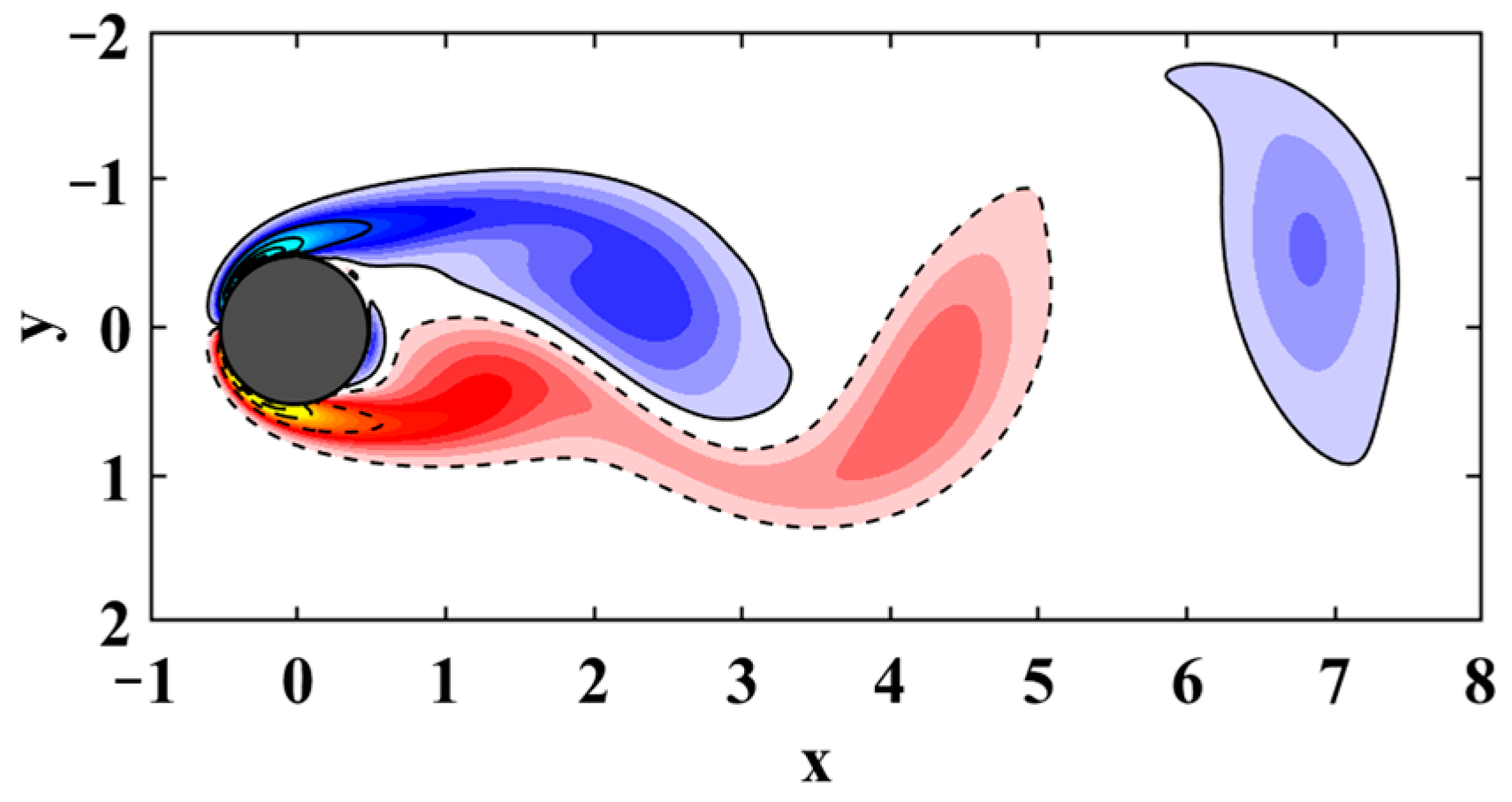

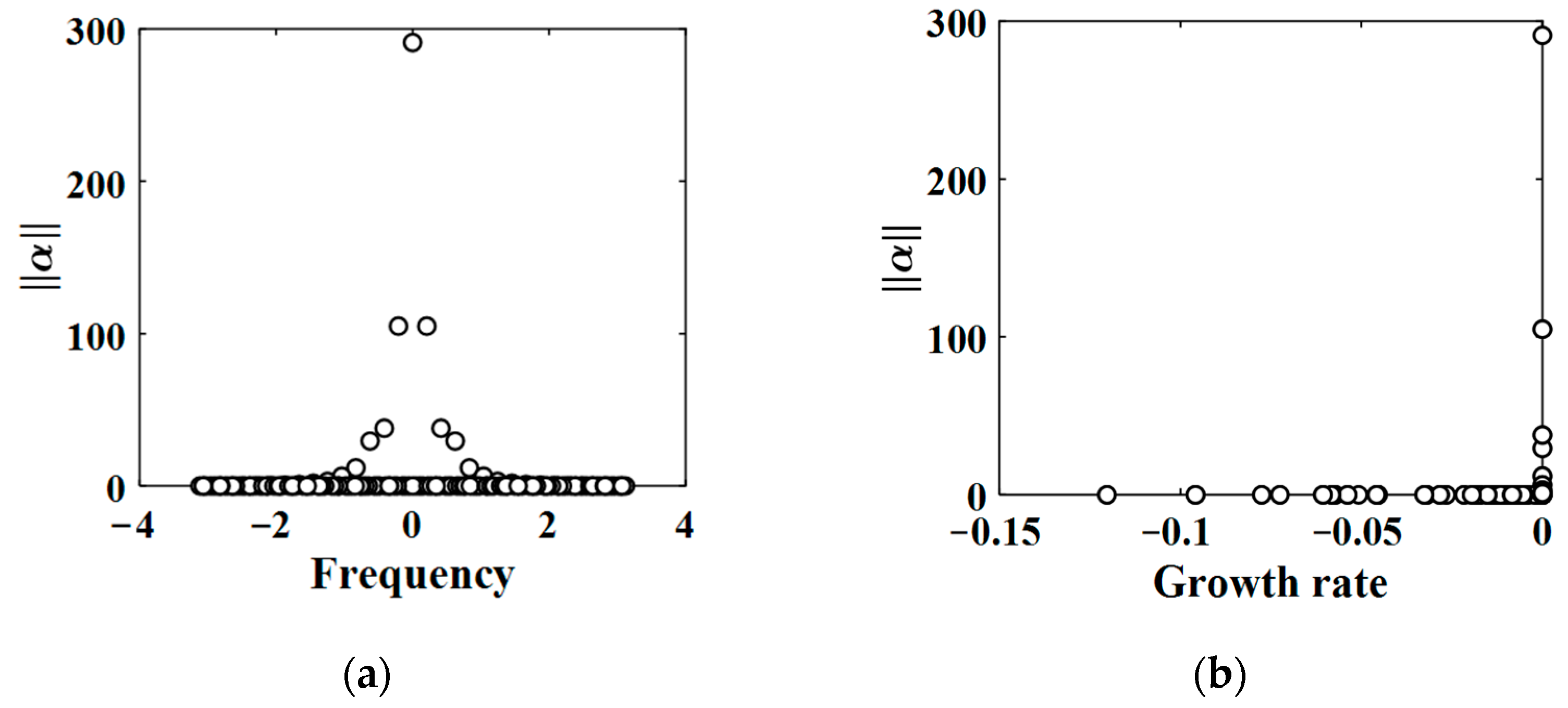
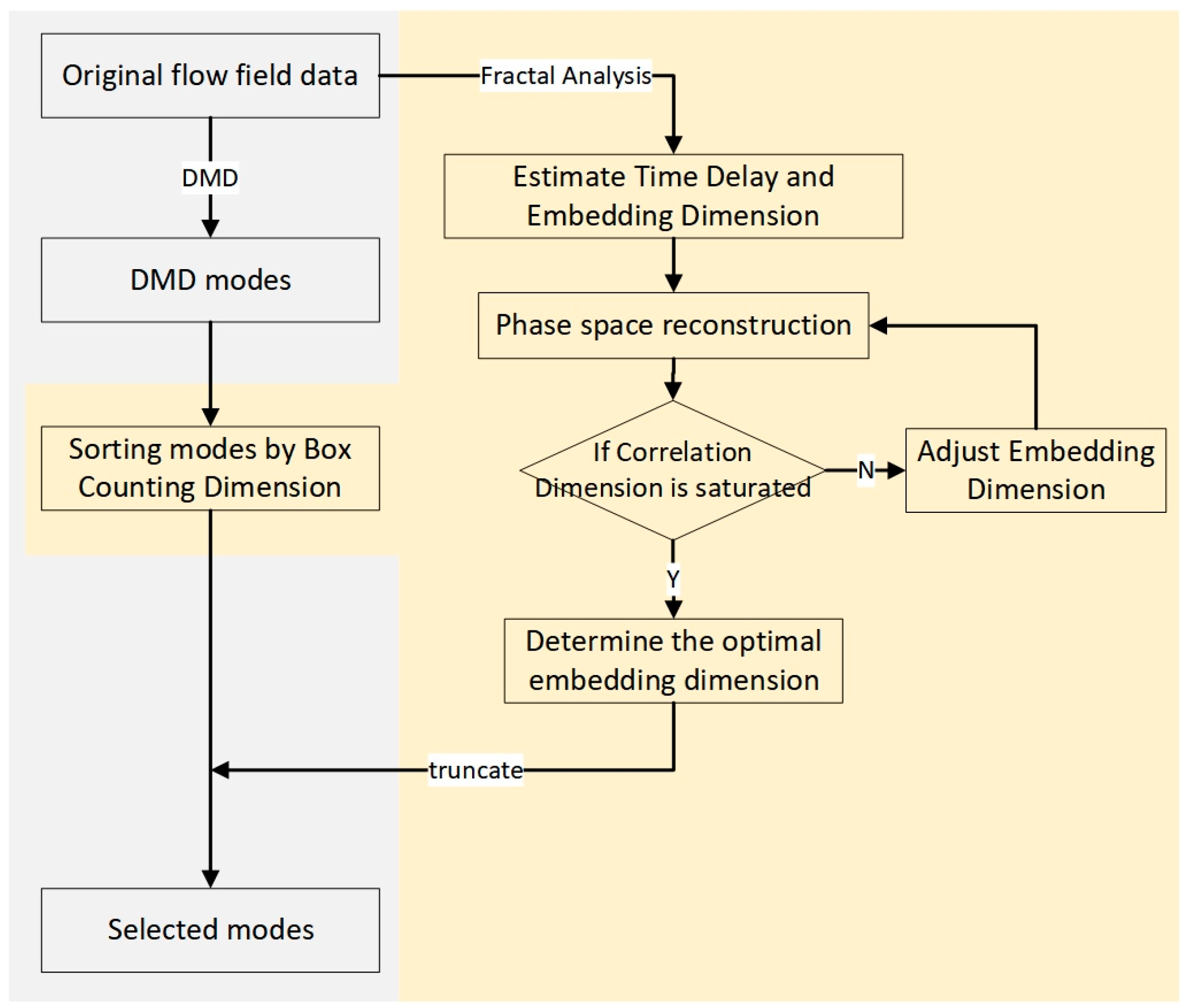
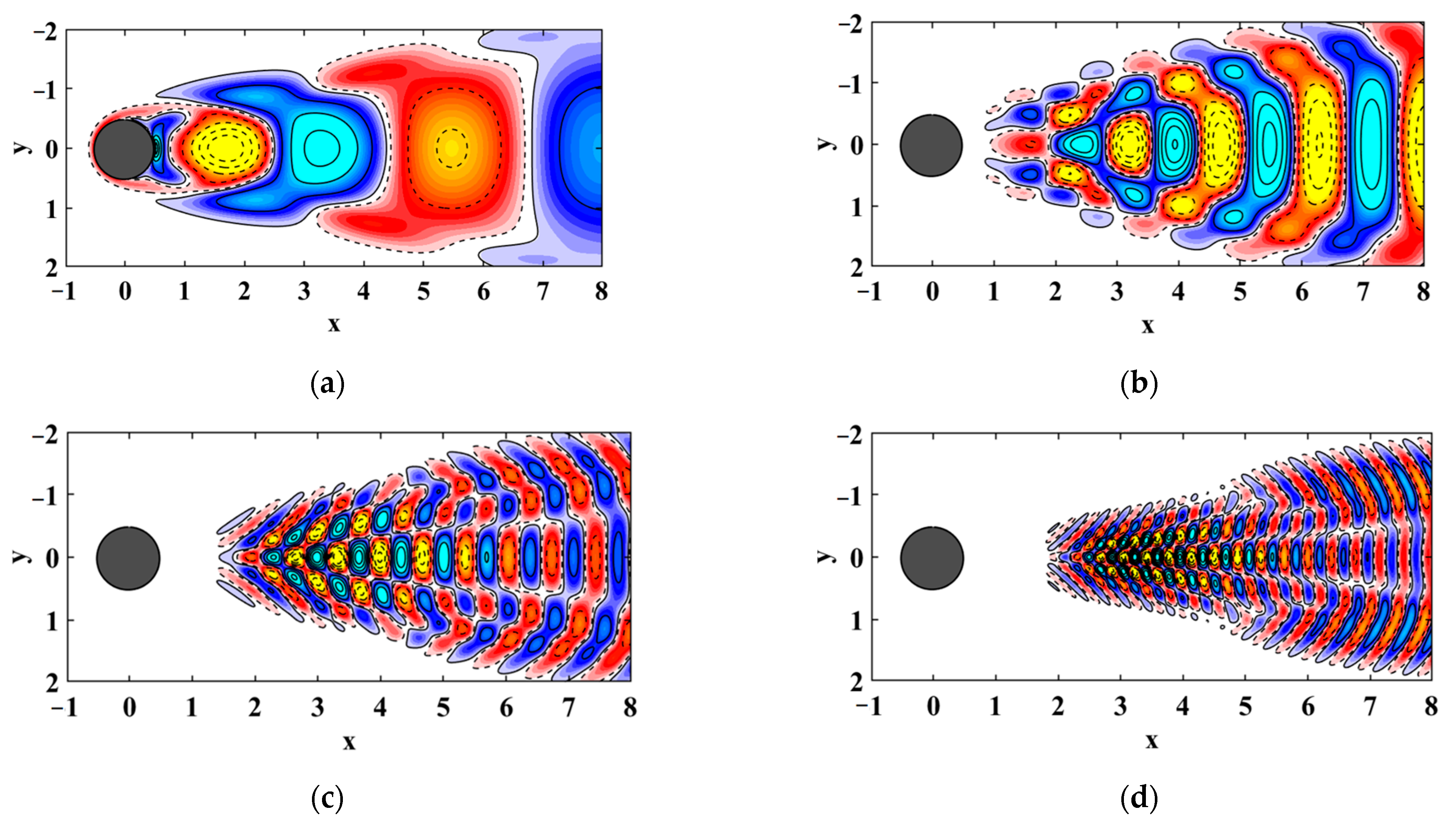
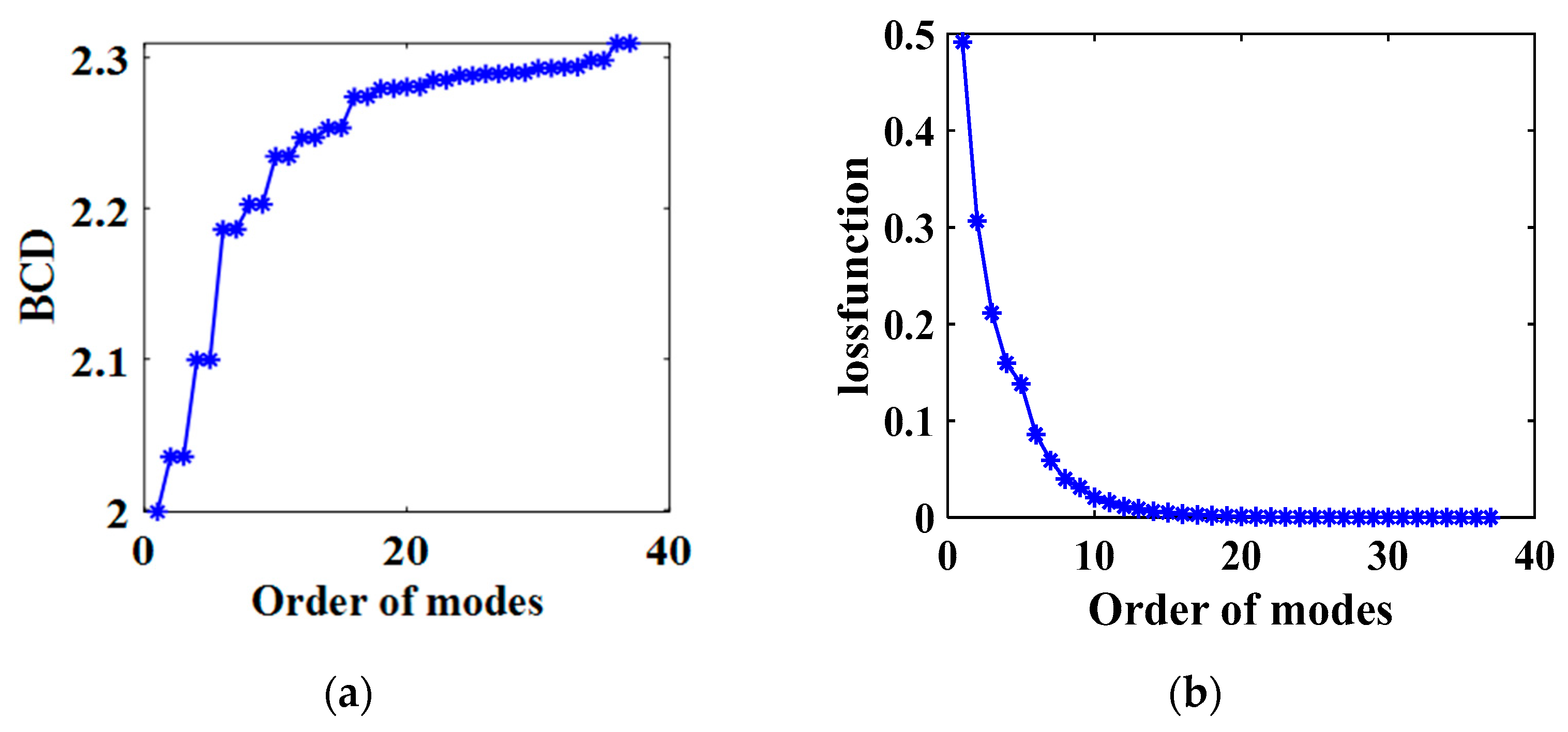





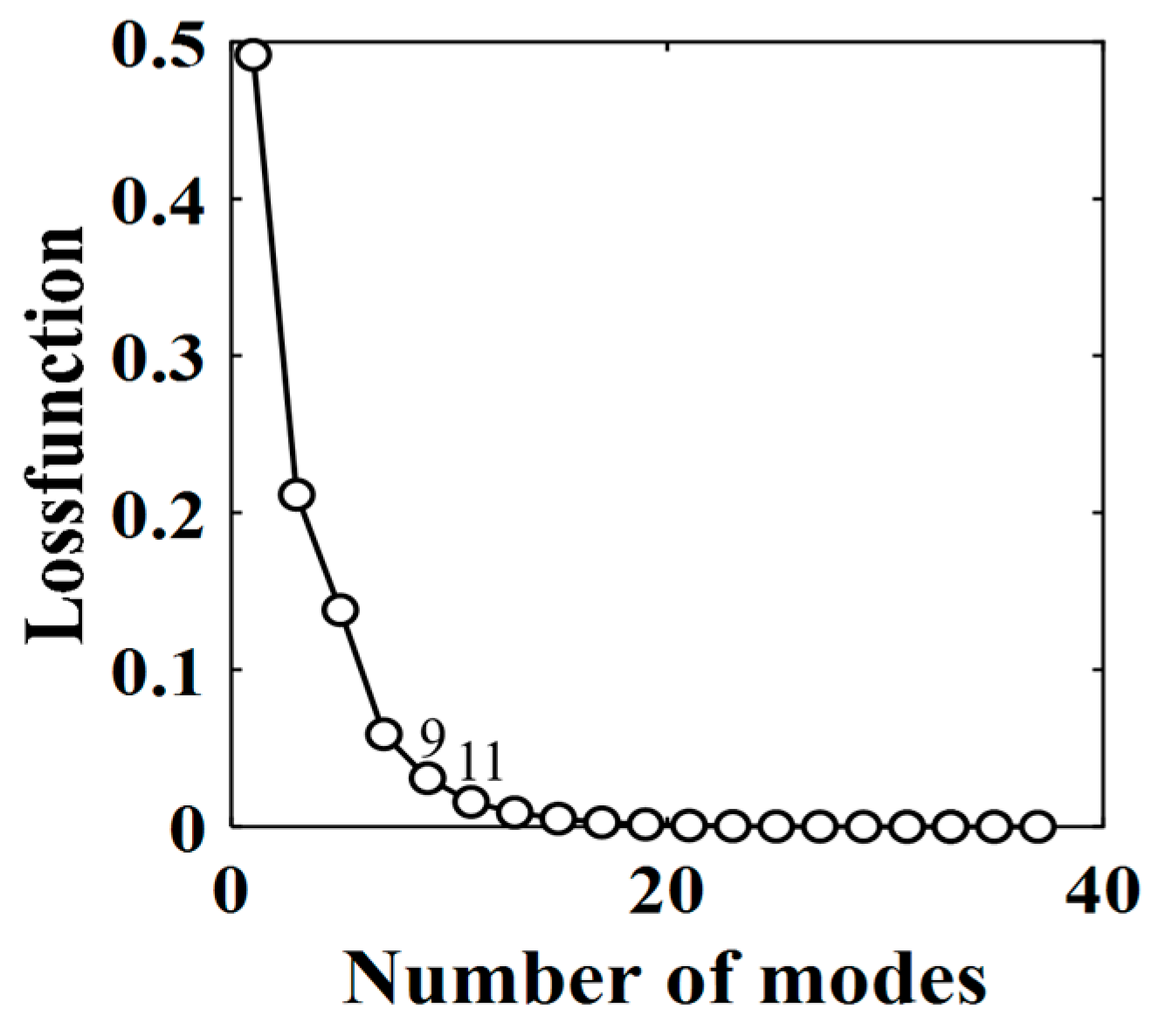
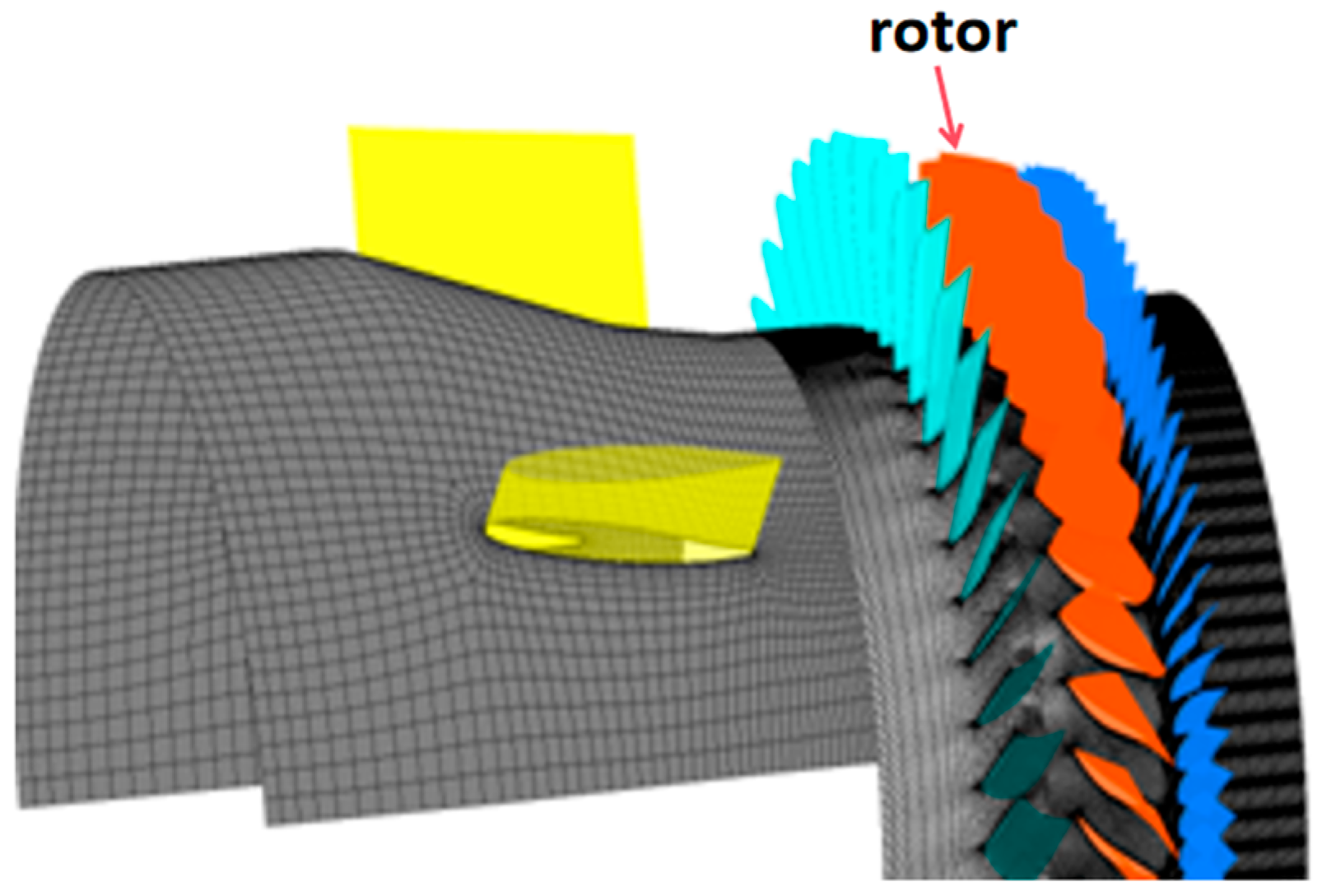



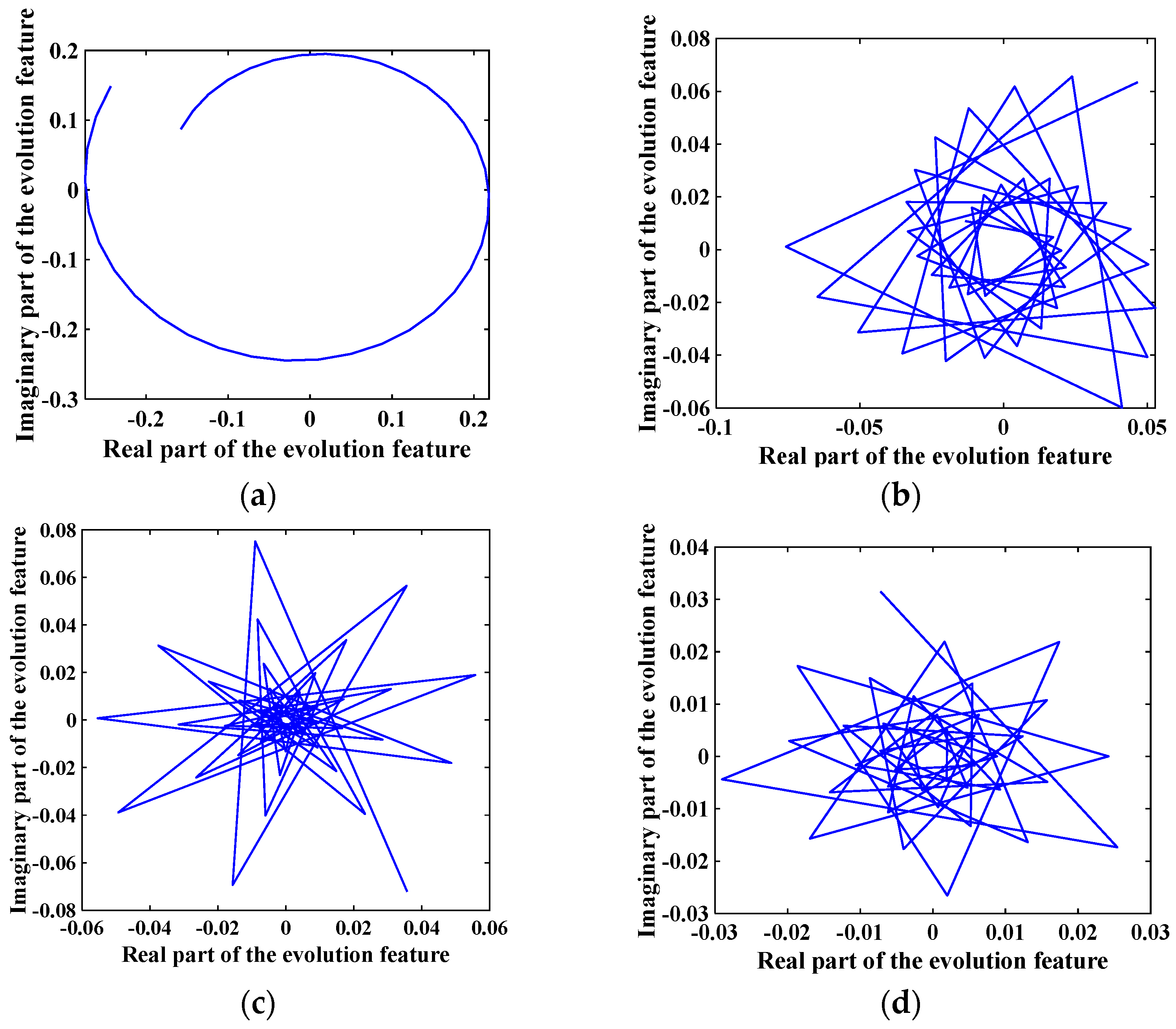
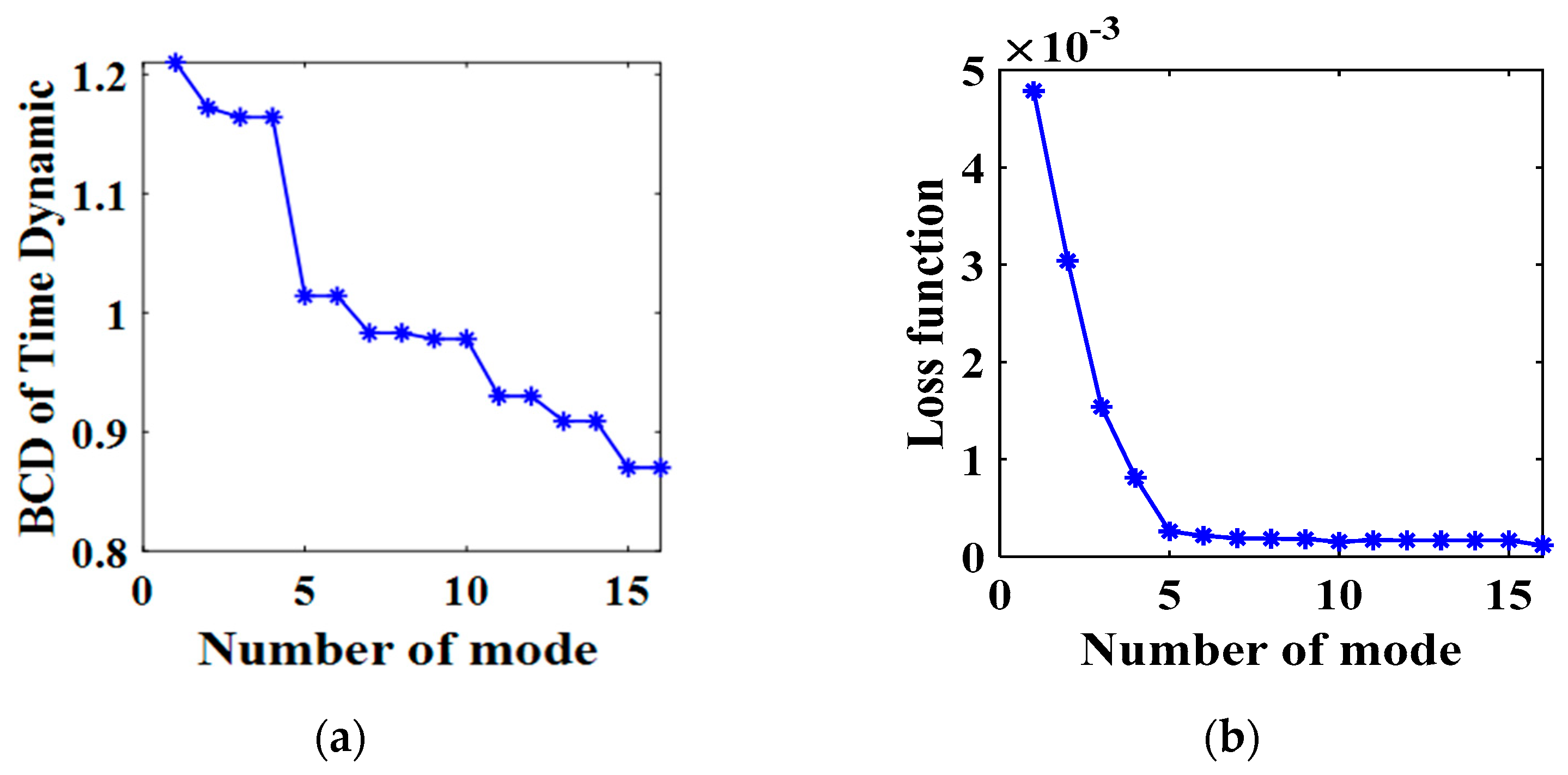

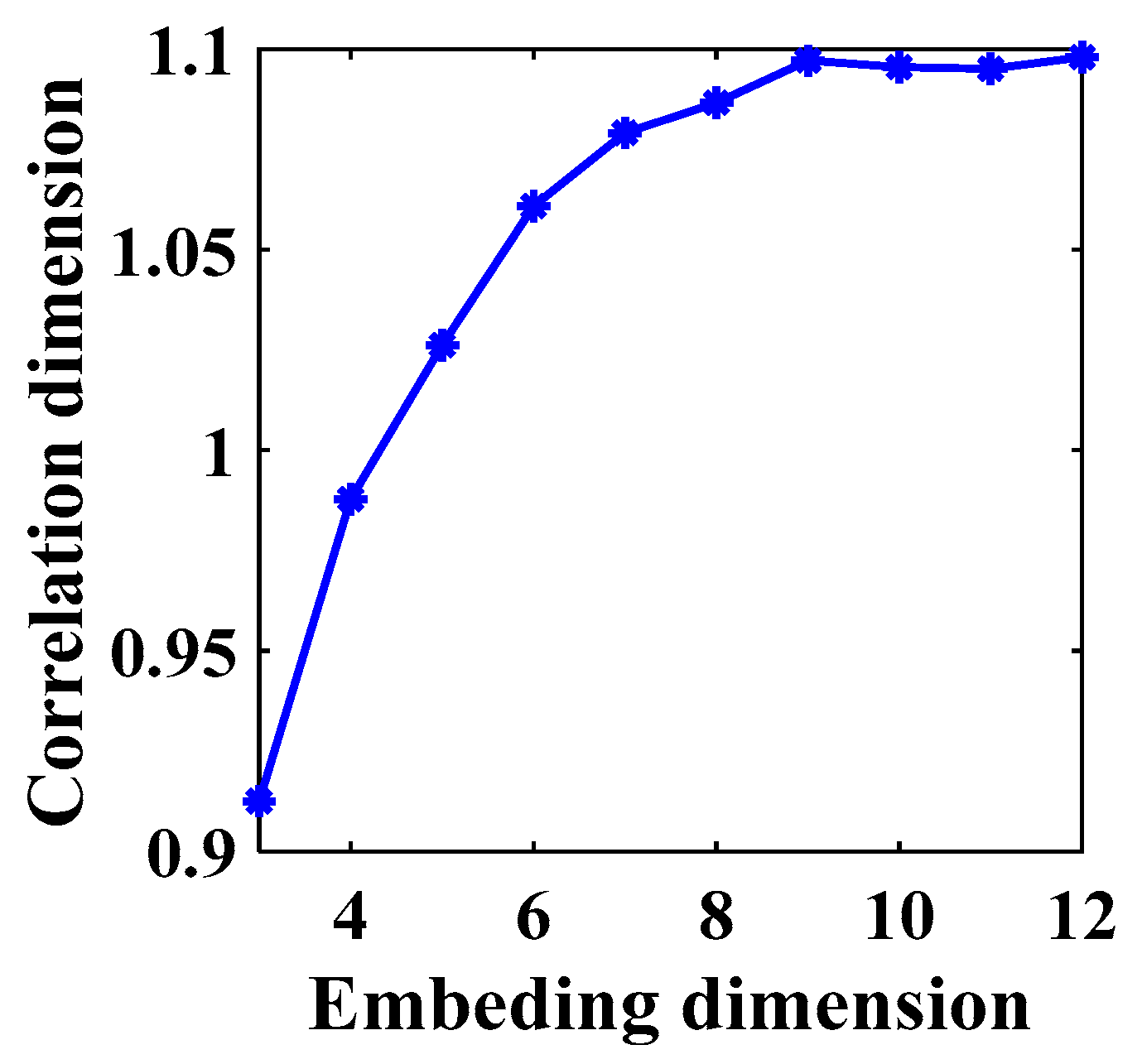

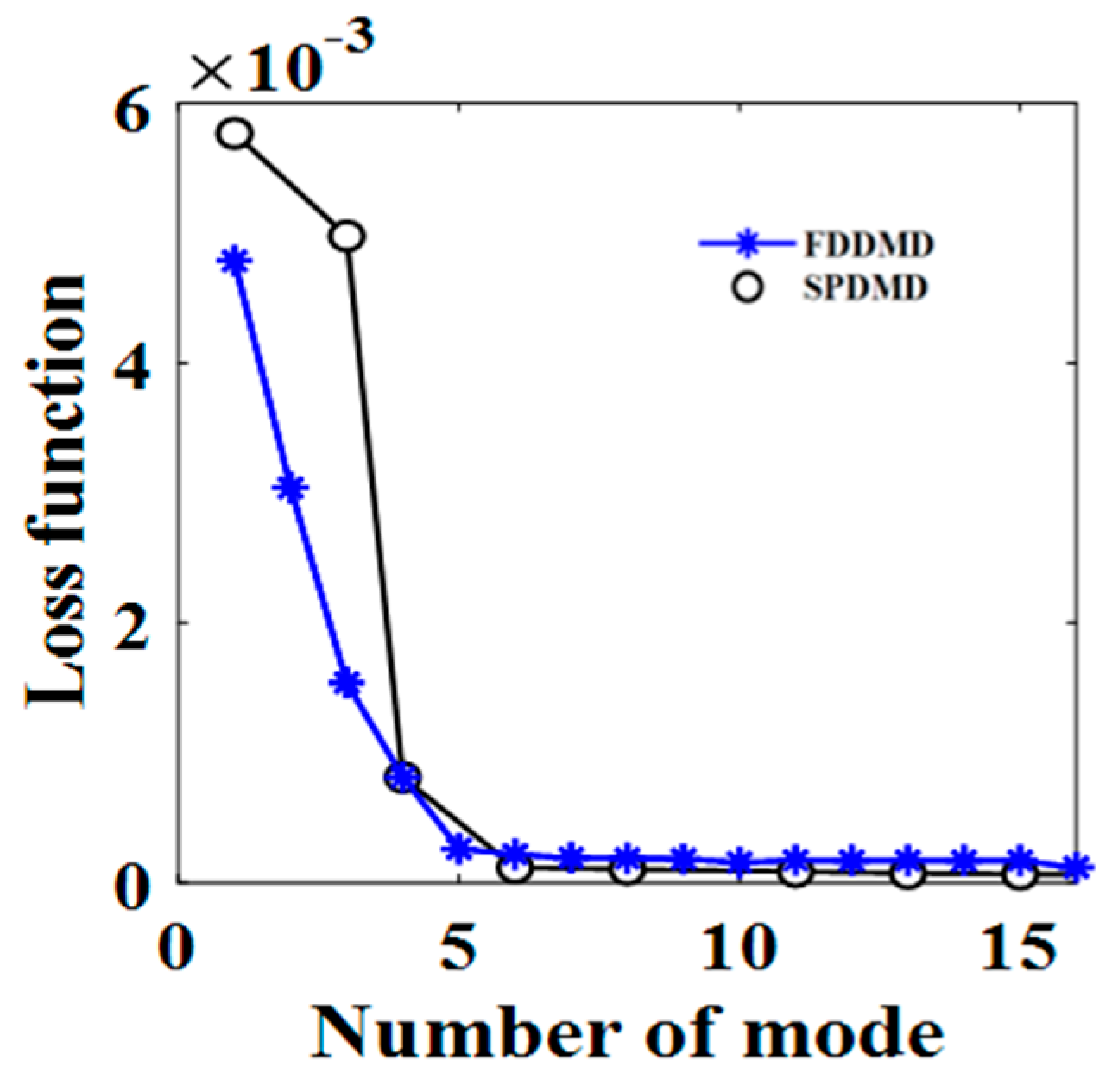

| SPDMD | FDDMD | |
|---|---|---|
| Number of Modes | 7 or 9 or 11 or 13 or 15 | 8 |
Disclaimer/Publisher’s Note: The statements, opinions and data contained in all publications are solely those of the individual author(s) and contributor(s) and not of MDPI and/or the editor(s). MDPI and/or the editor(s) disclaim responsibility for any injury to people or property resulting from any ideas, methods, instructions or products referred to in the content. |
© 2024 by the authors. Licensee MDPI, Basel, Switzerland. This article is an open access article distributed under the terms and conditions of the Creative Commons Attribution (CC BY) license (https://creativecommons.org/licenses/by/4.0/).
Share and Cite
Zhang, M.; Bai, S.; Xia, A.; Tuo, W.; Lv, Y. Reduced Order Modeling of System by Dynamic Modal Decom-Position with Fractal Dimension Feature Embedding. Fractal Fract. 2024, 8, 331. https://doi.org/10.3390/fractalfract8060331
Zhang M, Bai S, Xia A, Tuo W, Lv Y. Reduced Order Modeling of System by Dynamic Modal Decom-Position with Fractal Dimension Feature Embedding. Fractal and Fractional. 2024; 8(6):331. https://doi.org/10.3390/fractalfract8060331
Chicago/Turabian StyleZhang, Mingming, Simeng Bai, Aiguo Xia, Wei Tuo, and Yongzhao Lv. 2024. "Reduced Order Modeling of System by Dynamic Modal Decom-Position with Fractal Dimension Feature Embedding" Fractal and Fractional 8, no. 6: 331. https://doi.org/10.3390/fractalfract8060331
APA StyleZhang, M., Bai, S., Xia, A., Tuo, W., & Lv, Y. (2024). Reduced Order Modeling of System by Dynamic Modal Decom-Position with Fractal Dimension Feature Embedding. Fractal and Fractional, 8(6), 331. https://doi.org/10.3390/fractalfract8060331







